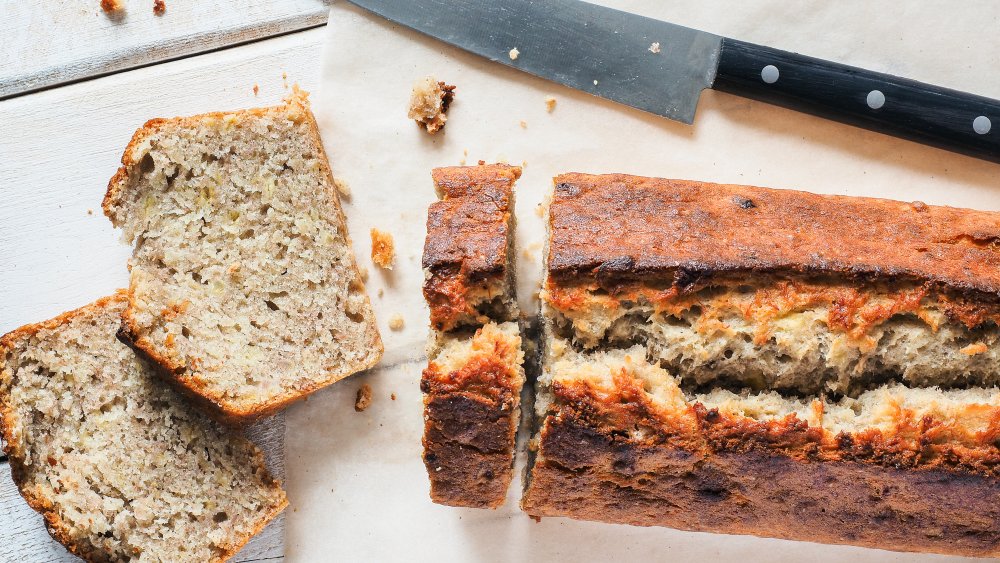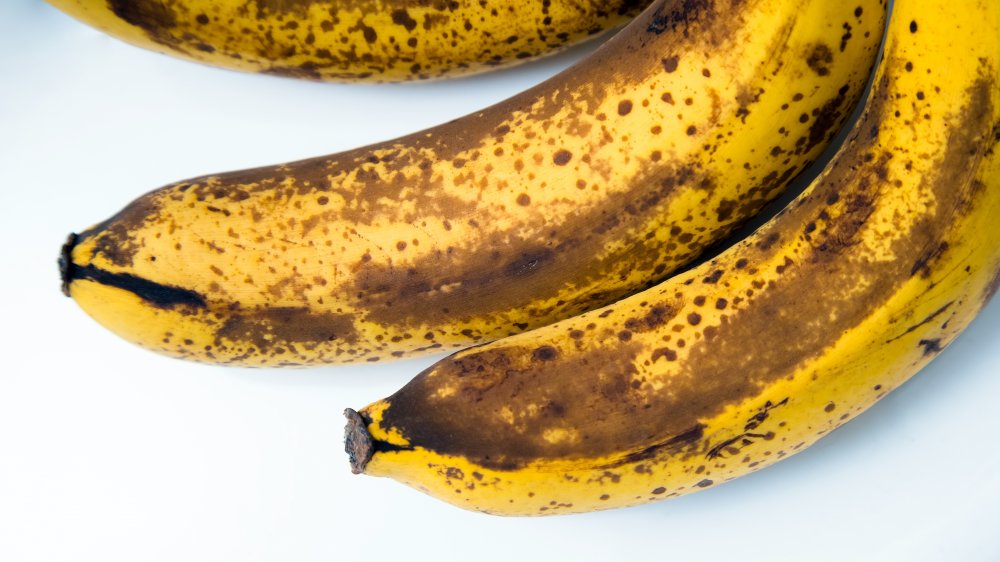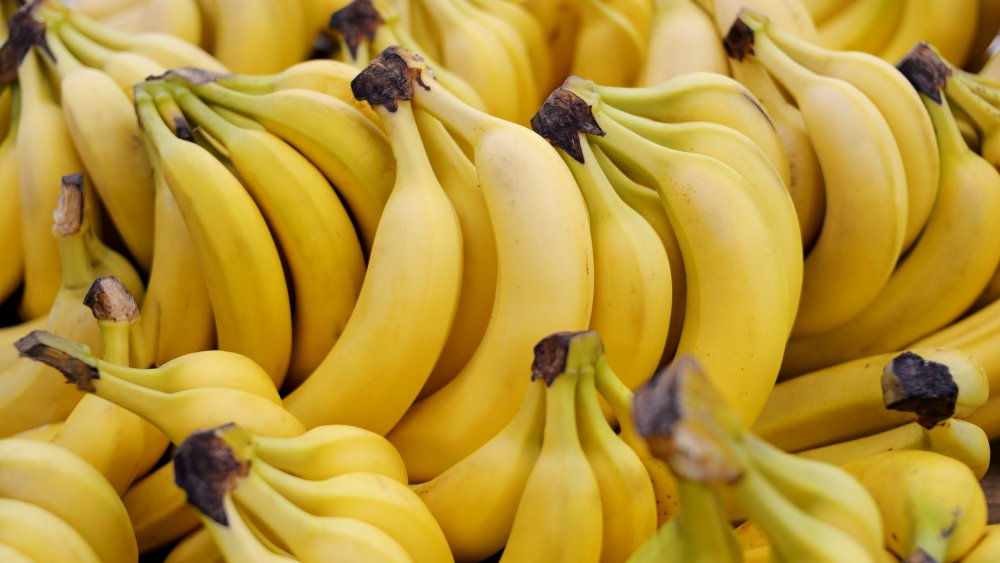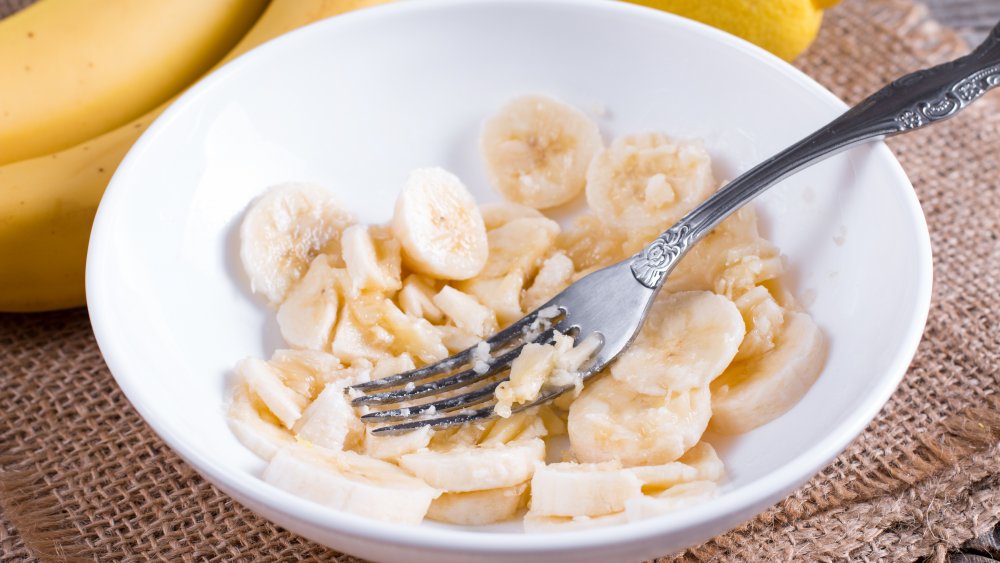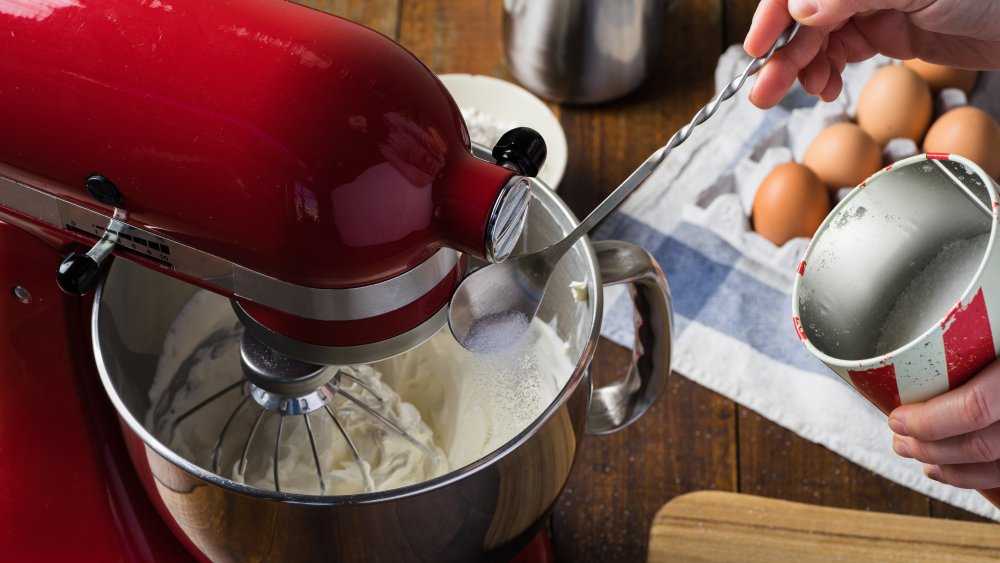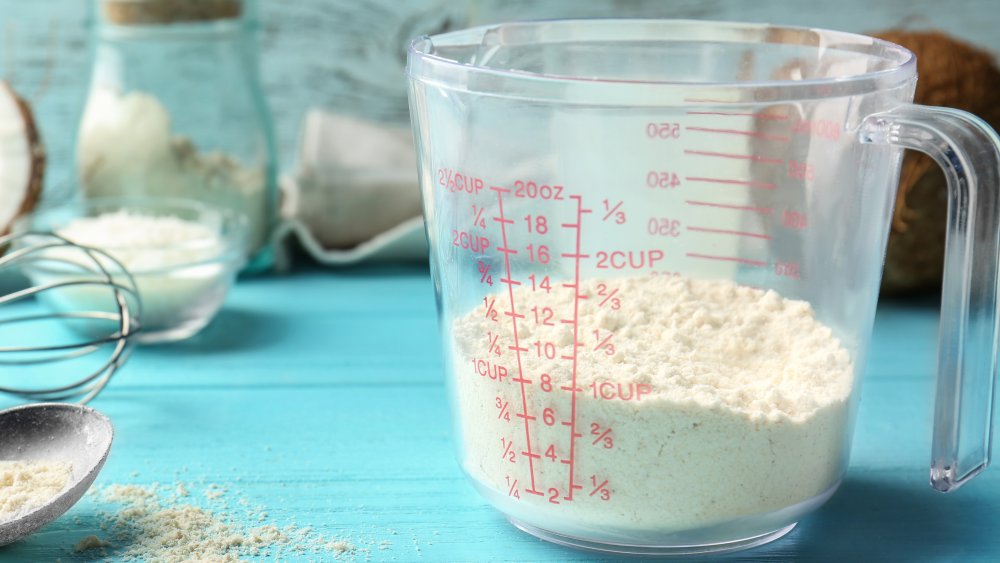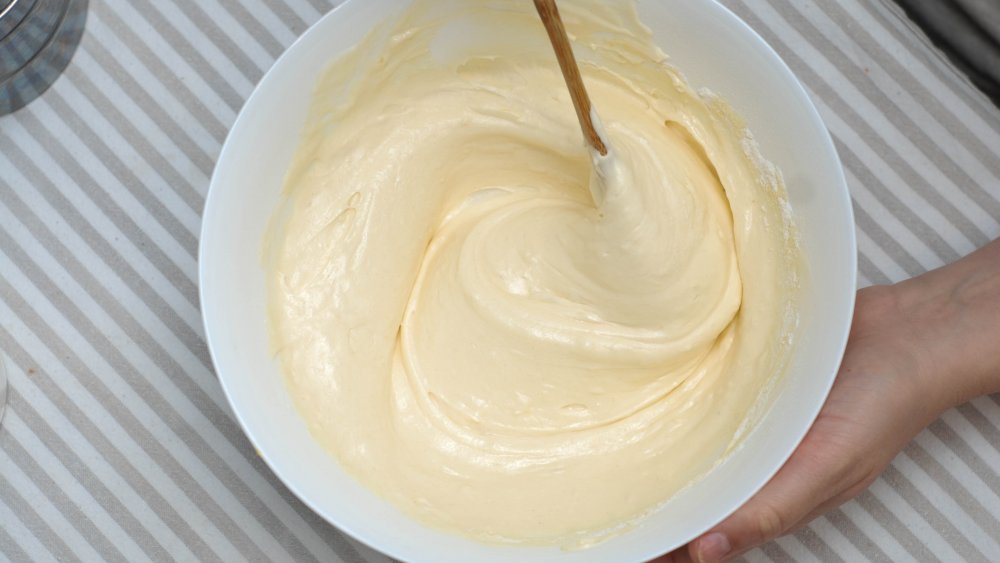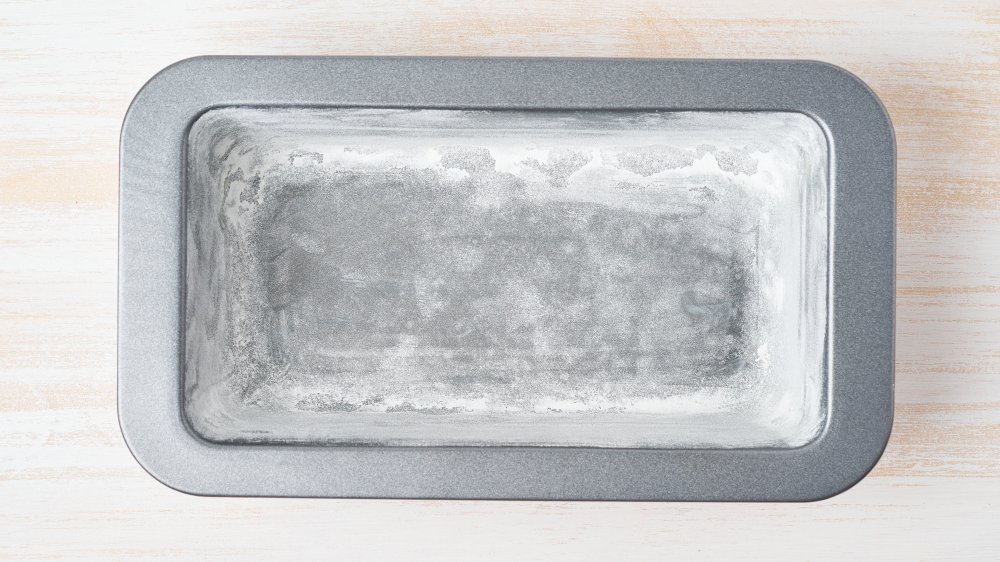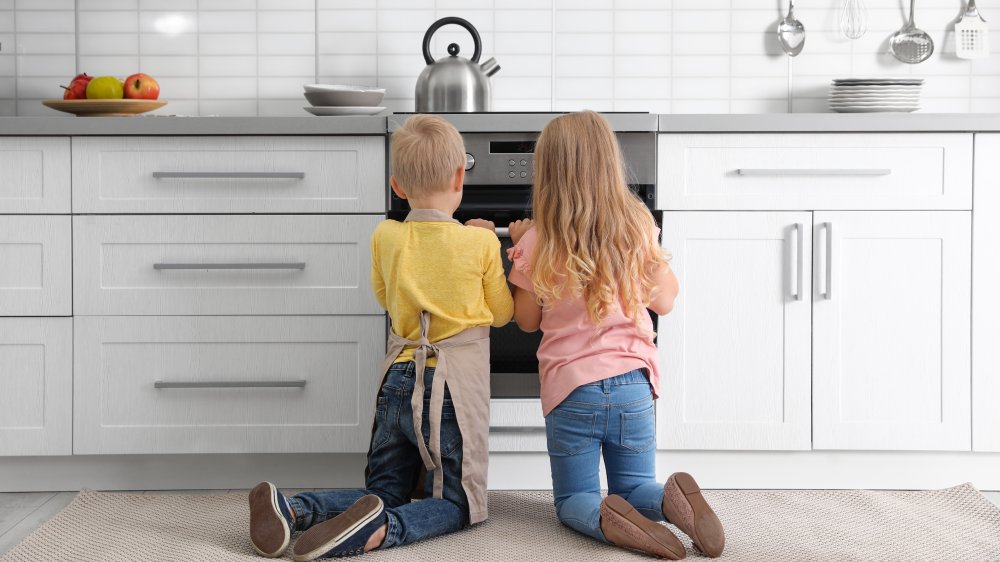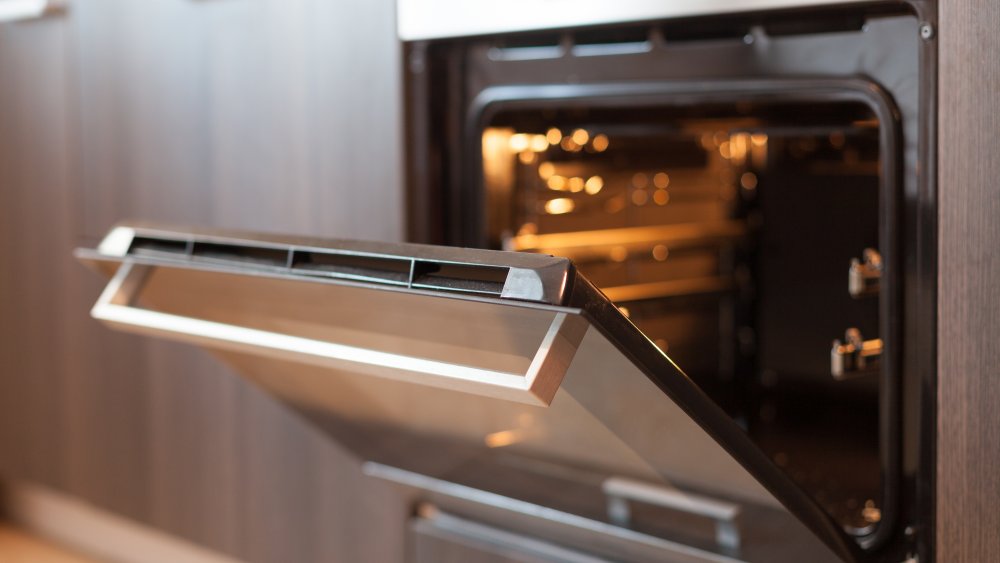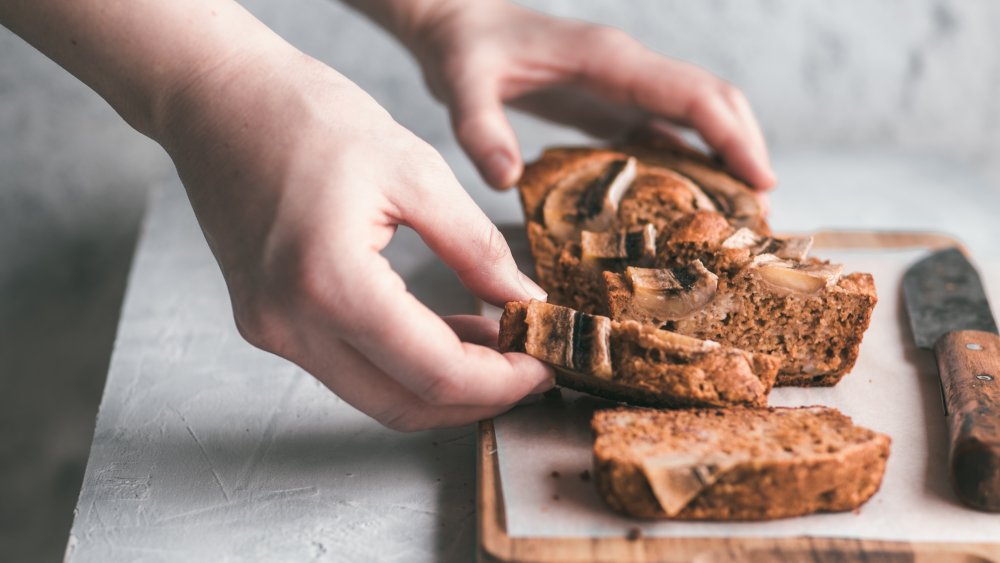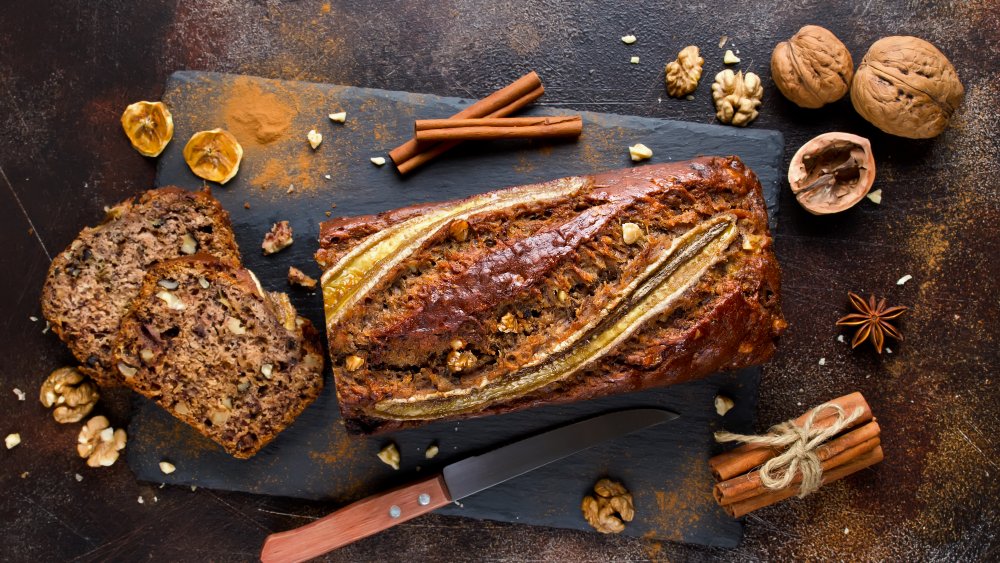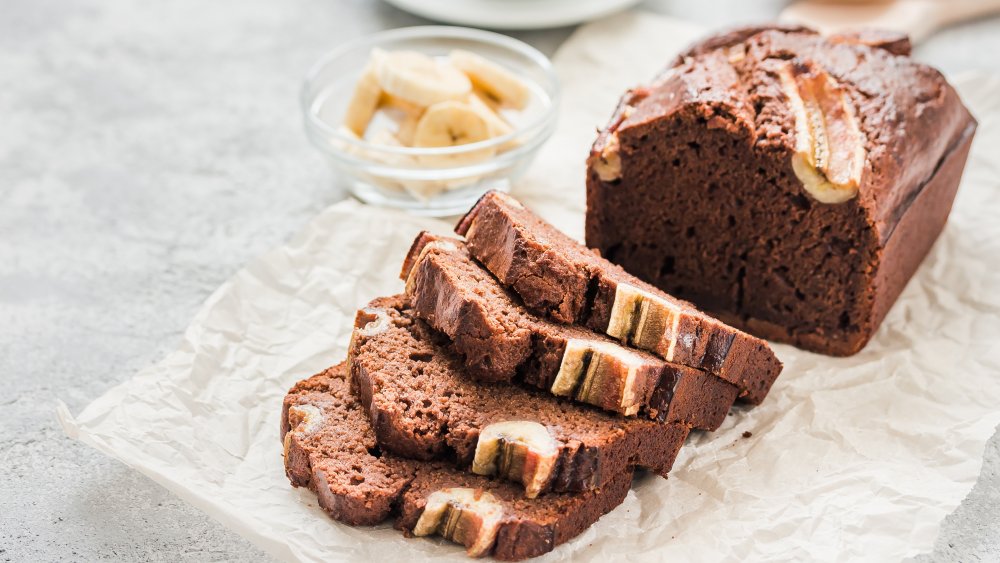Mistakes Everyone Makes With Banana Bread
Let's face it. Banana bread is the epitome of comfort food. Whether you dream about it due to childhood nostalgia thanks to your grandmother's perfected recipe, or you just find comfort in sitting with a buttered slice with a cup of coffee or tea, it's one of the most quintessential baked goods.
Banana bread comes with so many options, from adding peanut butter or nuts to even chocolate, as well as the option to either enjoy it cold with a spread of butter or warmed up. Not to mention, it's the most perfect (and easily portable) baked good for pretty much any time of day, from breakfast on the run to an afternoon snack. Really, it's perfection.
But what about when you want to bake your own banana bread? Luckily, in comparison to many other baking projects, like trying your hand at French macarons or a loaf of sourdough, banana bread is on the simpler side of the scale, and pretty much any experience level of baker can achieve a nice loaf. Most banana bread recipes out there vary slightly, from the type of fat introduced to whether it utilizes granulated sugar or a bit of brown sugar, but there are a few key steps that apply all across the board.
To be sure your banana bread comes out perfectly, there are a few tips that novices and experts alike need to keep in mind. These are the mistakes you might be making with banana bread.
Not using ripe enough bananas for your banana bread
First thing's first, banana bread, of course, requires bananas. After all, that's what gives your loaf its flavor and its lovely texture. But can you just grab any bananas from your kitchen counter fruit bowl and get to baking? Or even just grab a few at the store for your baking project? Absolutely not.
Banana bread requires super ripe bananas. We're talking ripe enough that they're starting to get brown spots on the peel. According to Real Simple, you want no green on the peel, but you also don't want your bananas ripe enough that they're rotten.
Insider explains that as a banana ripens, the starch in the fruit turns to sugar. Ultimately, they become sweeter the riper they are, which is why those with brown spots are utilized to add great flavor to baked goods. Whether your bananas are still at room temperature, or you chose to freeze a few old bananas you had let get too ripe for prime eating, the best banana bread will ultimately come from ripe bananas.
Waiting on your bananas to ripen faster so you can make banana bread
We already know how important it is to bake banana bread with ripe bananas. But what do you do if your bananas aren't actually quite to that stage yet?
Luckily, there are a few tricks for you to try. According to Food 52, if you want your bananas ripened lickety-split (so you can start baking within minutes), all you need to do is put them in the oven. Simply place your bananas on a baking sheet, or even use a square cake pan lined with parchment or foil. Crank up the oven to 300 degrees, put your bananas in, and wait for them to turn brown. While the method isn't totally perfect, because there's nothing better than letting nature do its thing, it's definitely a viable option instead of waiting. Adding the bananas to the oven at low heat will allow for the starches to develop, similarly to how they naturally ripen, and you'll end up with a mushy banana to use for banana bread.
The other option is to use the paper bag method, but it won't produce a ripened banana quite as quickly. If you're hoping to bake banana bread and speed up the process of ripening your fruit, you can place your bananas in a paper bag and leave it in a warm spot overnight. According to Chowhound, the fruit will produce ethylene gas and the starch will begin to convert to sugars to produce ripened fruit.
Not pre-mashing the bananas when making banana bread
So, you've decided to make banana bread. You have all of your ingredients, your bananas are ripe, and you're ready to go. After mixing the batter, you just put the bananas in whole, right? Sorry, not so fast.
Part of making banana bread is all about incorporating the sweet, ripe banana's flavor throughout. In order to achieve that, it's important to introduce the bananas in a way that can be easily incorporated, rather than having to break them down in the mixer with the rest of your ingredients.
According to The Kitchn, if you want to have banana bread with completely smooth bananas throughout, and no chunks, mashing them in a separate bowl before introducing them to the mixture is the best way to go. Using the back of a fork will do the trick wonderfully, or you can opt to use a whisk or a wooden spoon.
You mix your banana bread ingredients in the wrong order
Have you ever started a recipe, following the directions to mix all of the dry ingredients in a separate bowl and all of the wet in another bowl, and wondered why in the world that matters? Who needs the extra dishes?
Baking truly is an art form, but there is quite a bit of science to it as well, and if certain ingredients aren't introduced in the right order, they work differently with the other ingredients.
With a banana bread recipe, it doesn't work to just throw everything into a bowl, add in some mashed bananas, and cross your fingers. Much like baking a cake, baking banana bread requires a specific order of operations. Adding the dry ingredients to the wet ingredients allows for better introduction and incorporation. According to Cook's Illustrated, that order is actually crucial. If you were to instead add the wet ingredients to the dry bowl, you end up with pockets of flour rather than a smooth distribution. Plus, it's easier to fully mix things together without over-mixing, which can definitely hamper your banana bread's texture.
Adding too much flour to your banana bread
Depending on the banana bread recipe you're using, the amount of flour it calls to incorporate will certainly vary. Food Network's banana bread recipe calls for two cups of flour, while Bon Appetit's calls for one-and-a-half cups of flour. Whatever your recipe calls for, it's important to follow that to the letter.
According to Leaf, if you add too much flour, your banana bread will come out stiff and dry. And on the other hand, adding too little flour can cause your banana bread to be too wet. It's all about following the recipe's ratio and finding that perfect middle ground.
To be sure you're measuring your flour correctly, opt for a measuring cup specifically meant for dry measurements, and use a knife to level off the top of the cup once you scoop your flour. This will ensure you're not adding extra by mistake, ultimately making for a loaf of dry bread.
Overmixing your banana bread batter
As simple as the ingredients are for banana bread, and as achievable as the method seems, banana bread can be a bit finicky. Whether you opt to make your banana bread in a stand mixer, or you're simply using a bowl and a spoon, the key to a beautiful, fluffy, moist loaf is not to over-mix the batter.
According to Southern Living, the reasoning for not over-mixing is all about the gluten. As you mix, the gluten begins to develop. When too much gluten develops before baking, you can end up with a dense, chewy loaf, rather than the soft and delicious banana bread you were hoping for.
To avoid too much gluten development and achieve the perfect texture, it's best to start by making sure your wet ingredients are fully combined before you introduce your dry ingredients. When it's time to add the dry ingredients, gently fold them in — maybe even using a spoon and not a mixer — just until everything is fully incorporated.
Not greasing the pan enough for your banana bread
The last thing you want after you've gone to all the work of baking the perfect banana bread is to not be able to remove the loaf from the pan. After all, how are you going to post that Instagram-worthy photo of your latest baking project if it's all cut up or there are chunks of bread missing?
Luckily, with a little prep ahead of time, that can be avoided. Whether you're using a metal or a glass loaf pan, greasing your pan with oil or butter will help your banana bread come out smoothly. Either using canned oil spray or simply rubbing butter or shortening along the insides of the pan will create a layer of oil that makes for easy release. Sprinkling the pan with flour after buttering will really make sure nothing sticks while baking.
Opting for parchment paper is another possibility as well. According to Bon Appetit, that's the way to go, allowing for a smooth release by just lifting up the paper. Whichever way you choose is up to you, but definitely be sure to choose one. Digging your banana bread out of the loaf pan with a fork really isn't the best way to eat it.
Not baking your banana bread long enough
Most baked goods don't really take that long to bake. Cookies? Typically you'll leave them in for 10-12 minutes. Cupcakes? 20 minutes give or take. But banana bread? It takes a wildly long time, and you don't want to skip out on that bake time.
Most banana bread recipes, such as The Kitchn's, requires banana bread to be baked at 350 degrees for 50 to 65 minutes. And while that may seem like a huge range, there's a reason for it. According to The Kitchn, your bake time will depend on how moist your bananas are and the sugar content of them. Often, if you make banana bread and cut into it only to find a gooey, underbaked center, that's the reason. It's thanks to those bananas not having enough time.
It's best to begin checking your banana bread sooner rather than later, but don't pull it out of the oven until you've checked that it's fully baked. The top and sides will be a caramel, dark brown, with a yellow bread color in the center, but check it with a toothpick to be sure it's done. Insert a toothpick into the middle to check if it comes out clean. If it's clean, or there are only a few crumbs, it's ready to pull out.
Not baking your banana bread at the right temp
As important as it is to bake your banana bread long enough, it's also important to pop your loaf in the oven at the correct temperature. And if you're baking a loaf that, quite literally, seems to be taking forever to bake, and you decide to crank up the heat to make things go faster, you'll only end up ruining your loaf.
Trust your recipe from the very beginning when it comes to oven temperatures, and make sure your oven is clocking in at the correct temp. The majority of banana bread recipes call for a baking temperature of 350 degrees, and you'll want to make sure you keep it at that temp the whole way through.
It's also important to remember that we preheat ovens for a reason. Don't put your loaf in right when you turn on the oven, because it won't get proper heat for the right amount of time. Check to make sure your oven is up to temp before your loaf goes in to achieve the ideal bake.
Not cooling your banana bread long enough
You've selected the perfect ripe bananas, mixed your batter, and baked your bread. It's time to eat it once you pull it out of the oven, right? After all, what's better than warm, freshly baked banana bread? Well, not so fast. As with many of the steps of baking banana bread, there's a science to it.
Because you pair sugar with banana in your batter, the bananas tend to caramelize while baking. This also creates a bit of a gooeyness to the bread if you were to slice it right when it came out of the oven. It's best to let your loaf sit in the pan to finish baking for a few minutes on top of the oven, solidifying the banana mash.
According to Livestrong, letting your bread sit for 15 minutes before removing it from the pan is best. From there, you can invert your loaf pan onto a plate, use a spatula to get the loaf out if needed, and then let it rest a bit longer. It's best to eat banana bread when it's completely cooled, giving you the ability for a nice, clean slice.
Not adding mix-ins to take your banana bread to the next level
Of course, banana bread is delicious on its own. With its sweet, smooth texture and hints of banana flavor, it's the perfect quick bread. But have you tried it with add-ins to really amp it up?
Certainly, there are plenty of banana bread purists who will say nothing should be added and that it's perfect just as-is, but introducing a few more surprises in the batter may be just what you were looking for to make your banana bread that much better. According to Spoon University, one of the best ways to add an immediate kick of flavor is to introduce a tiny bit of cinnamon and nutmeg. Baking spice adds a nice flavor to the banana that's not too overpowering.
According to Greatist, adding walnuts or pecans are the most popular types of nuts to include, but you can opt for anything from pumpkin seeds and pistachios to even macadamia nuts to switch up the texture. You may also consider adding fresh fruit like blueberries or strawberries, a swirl of peanut butter, or chocolate chips to change the flavor and certainly make banana bread that's nowhere near boring.
Not remembering to be forgiving with yourself when you make banana bread
Chances are, if you're working on perfecting your first (or tenth) loaf of banana bread, you're probably not an expert baker. And truth be told, not many people are. Baking can be a hobby or a stress reliever for so many people — especially when it comes to baking banana bread, which is the ultimate comfort food. But be sure to remember to give yourself some grace as you learn. That loaf may not come out perfectly the very first time, and that's perfectly fine. It's important not to be discouraged and to find ways to learn from it.
King Arthur Flour recommends taking notes on your recipe, your oven, and your ingredients as you go. If you tried a recipe that was super flavorful, but it turned out a bit dry, take note and try to understand why that might be. Could it have been over-mixing the batter, even though the banana ratio was perfect? It certainly is a possibility. Or maybe you need a bit less flour the next time.
The good news with banana bread is that even if it doesn't come out perfectly the first time, as long as it's pretty well baked, it will probably still be ridiculously delicious. And if it comes out a bit underbaked, simply cut around the middle and still plan on enjoying a slice.
